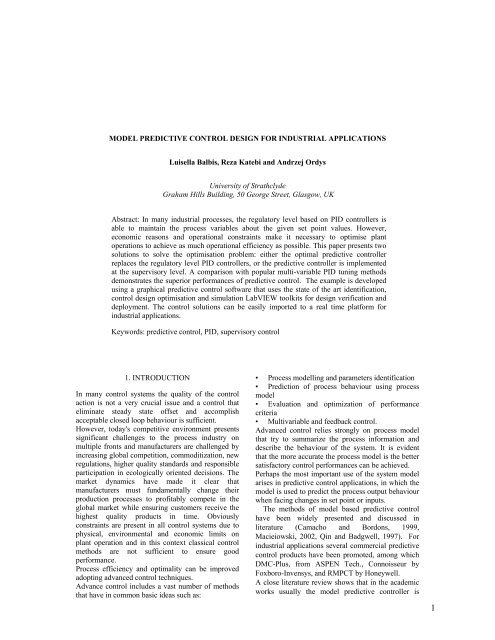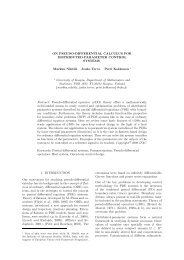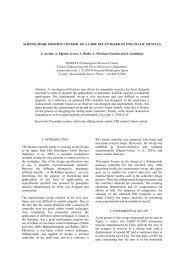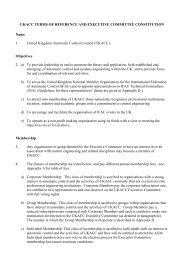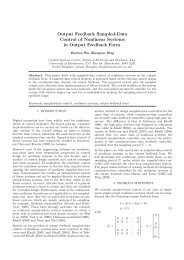MODEL PREDICTIVE CONTROL DESIGN FOR INDUSTRIAL ...
MODEL PREDICTIVE CONTROL DESIGN FOR INDUSTRIAL ...
MODEL PREDICTIVE CONTROL DESIGN FOR INDUSTRIAL ...
You also want an ePaper? Increase the reach of your titles
YUMPU automatically turns print PDFs into web optimized ePapers that Google loves.
<strong>MODEL</strong> <strong>PREDICTIVE</strong> <strong>CONTROL</strong> <strong>DESIGN</strong> <strong>FOR</strong> <strong>INDUSTRIAL</strong> APPLICATIONSLuisella Balbis, Reza Katebi and Andrzej OrdysUniversity of StrathclydeGraham Hills Building, 50 George Street, Glasgow, UKAbstract: In many industrial processes, the regulatory level based on PID controllers isable to maintain the process variables about the given set point values. However,economic reasons and operational constraints make it necessary to optimise plantoperations to achieve as much operational efficiency as possible. This paper presents twosolutions to solve the optimisation problem: either the optimal predictive controllerreplaces the regulatory level PID controllers, or the predictive controller is implementedat the supervisory level. A comparison with popular multi-variable PID tuning methodsdemonstrates the superior performances of predictive control. The example is developedusing a graphical predictive control software that uses the state of the art identification,control design optimisation and simulation LabVIEW toolkits for design verification anddeployment. The control solutions can be easily imported to a real time platform forindustrial applications.Keywords: predictive control, PID, supervisory control1. INTRODUCTIONIn many control systems the quality of the controlaction is not a very crucial issue and a control thateliminate steady state offset and accomplishacceptable closed loop behaviour is sufficient.However, today's competitive environment presentssignificant challenges to the process industry onmultiple fronts and manufacturers are challenged byincreasing global competition, commoditization, newregulations, higher quality standards and responsibleparticipation in ecologically oriented decisions. Themarket dynamics have made it clear thatmanufacturers must fundamentally change theirproduction processes to profitably compete in theglobal market while ensuring customers receive thehighest quality products in time. Obviouslyconstraints are present in all control systems due tophysical, environmental and economic limits onplant operation and in this context classical controlmethods are not sufficient to ensure goodperformance.Process efficiency and optimality can be improvedadopting advanced control techniques.Advance control includes a vast number of methodsthat have in common basic ideas such as:• Process modelling and parameters identification• Prediction of process behaviour using processmodel• Evaluation and optimization of performancecriteria• Multivariable and feedback control.Advanced control relies strongly on process modelthat try to summarize the process information anddescribe the behaviour of the system. It is evidentthat the more accurate the process model is the bettersatisfactory control performances can be achieved.Perhaps the most important use of the system modelarises in predictive control applications, in which themodel is used to predict the process output behaviourwhen facing changes in set point or inputs.The methods of model based predictive controlhave been widely presented and discussed inliterature (Camacho and Bordons, 1999,Macieiowski, 2002, Qin and Badgwell, 1997). Forindustrial applications several commercial predictivecontrol products have been promoted, among whichDMC-Plus, from ASPEN Tech., Connoisseur byFoxboro-Invensys, and RMPCT by Honeywell.A close literature review shows that in the academicworks usually the model predictive controller is1
5. DEMONSTRATION EXAMPLEIn order to illustrate the performance of predictivecontroller at regulatory and supervisory level,various simulations have been carried out using aPredictive Control toolkit developed for LabVIEW.The experimental results are compared withmultivariable PID controllers tuned using thecombined methods described above.The system to control is a stable non minimum phaseMIMO system which transfer function is( − s )⎡Y1 0.5 1A ⎤ ⎡⎤0.75 ⋅⎡UA ⎤⎢ ⎥ ⎢2⎥( 1+ 0.25s+ s ) 1+s ⎢ ⎥⎢ ⎥ ⎢⎥= ⎢ ⎥⎢ ⎥ ⎢1( 1−0.5s) ⎥ ⎢ ⎥⎢ ⎥ ⎢0.75 ⋅ ⎥2⎢ ⎥⎣YB ⎦ ⎢ 1+ s( 1+s ) ⎥⎣UB⎣⎦ ⎦The discrete transfer function used to generate allmodel-based controllers was obtained discretizingthe system with sampling time T s =0.1s.The multi-loop regulatory level controller isconstituted by four nominal multivariable PIDcontrollers. The settings used for the PID controllerare displayed on the table 1.Figure 5 PID (--), MPC (-) input unconstrained caseA main feature of model predictive controllers is theability to handle constraints in explicit way. Figure 6shows the case of regulatory MPC subject to theinputs constraints 0 ≤ u ( k ) ≤ 5In the second scenario presented in figures 7 and 8,a nominal multivariable regulatory level PIDcontroller controls the process and a MPC controlleris placed at the supervisory level according to thecascade and parallel structures presented above.Table 1 PID Controller Tuning Parametersp ε d K p K i K d0.9 0.7 0.001⎡−1.04 2.16 ⎤ ⎡−1.71 2.29 ⎤ ⎡0 1⎤p ⋅ ε⋅ d ⋅⎢⎣ 1.67 −1.72⎥ ⎦⎢⎣ 2.29 −1.71⎥ ⎦⎢⎣1 0⎥⎦Figures 4 to 8, show the process output and input ascontrolled by the nominal regulatory level controller(PID), regulatory level MPC controller and thesupervisory MPC controllers. For simplicity, it isconsidered only the case in which the multi-loopregulatory level controller is constituted by fournominal multivariable PID controllers tuned usingthe combined method.The MPC design tuning parameters are: N p = 25;N u = 1; N w = 1; Q(t) = diag(2,1), R(t)=diag(1,1).Figures 4 and 5 show the trajectory of input andoutput obtained applying multi-loop PID and MPCcontroller at regulatory level. It can be noticed thatin both cases the oscillatory, non-minimum phasedynamics are effectively dominated. However usinga predictive controller gives smaller overshoot andshorter settling time.Figure 6 PID (--), MPC (-) input constrained caseComparing the results in Figures 4 and 6, it can beobserved that the system response of the processwhen under direct MPC control at the regulatorylevel is similar to the response when the MPCcontroller is used at the supervisory level. Thepurpose of this simulation is to show that a MPCcontroller can be easily implemented at top level ofan already existing control structure. In this wayadditional objectives and constraints such aseconomical criteria can be redefined withoutconsidering the PID replacement at the loop level.Figure 4 PID (--), MPC (−) output unconstrainedcaseFigure 6 PID+ MPC output cascade configuration (-)and parallel configuration (- -)5


